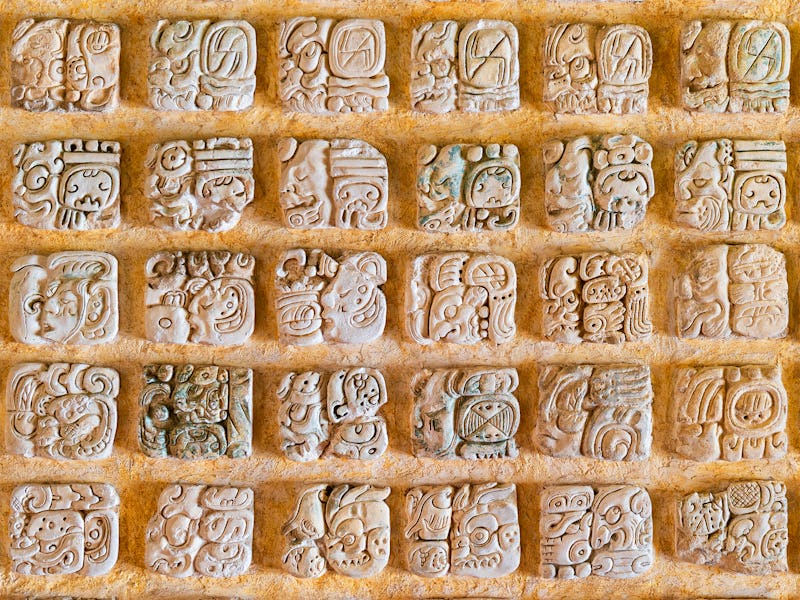The Mayan calendar is older than we thought, researchers say
A site in Guatemala housed the oldest known example of a written calendar date in Maya civilization.

If you thought 365 days was a long time, try resetting your calendar every 18,980 days instead. 52 solar years make up the longest cycle of the Mayan calendar – a complex and ancient system that’s been used by indigenous peoples in North and Central America for thousands of years.
Archaeologists have deduced a lot about mesoamerican timekeeping and writing systems from well-preserved texts, monuments, and paintings. But there is still a lot left that they don’t know about the origins and widespread adaptation of these systems.
Mayan glyphs at a site in Guatemala.
Writing in the journal Science Advances this week, researchers analyzed painted plaster fragments from an ancient Maya pyramid in modern-day Guatemala. They discovered the earliest evidence of a written calendar date, along with intricate calligraphy that sheds light on the evolution of Maya writing systems.
Here’s the background — In a heavily forested area of Guatemala are the remains of San Bartolo, an early Mayan town. Most famously, San Bartolo houses a pyramid complex called Las Pinturas, which is known for its stunning paintings that depict scenes of sacrifice, ritual, and the lives of the gods.
Ancient Mayan paintings in Mexico, dating back to the eighth century A.D.
It’s likely that the town was once a gathering space for ceremonies or markets, explains archaeologist and art historian David Stuart of the University of Texas at Austin, a co-author on the study. It’s fairly middling in size compared to other Maya sites, and probably drew in visitors who lived and farmed in surrounding areas like a lot of ancient hubs.
“This was the early landscape of the Maya — this kind of rainforest area dotted with towns and cities,” Stuart tells Inverse.
The paintings at San Bartolo date back to the Late Preclassic Era of Maya civilization, a time in history that isn’t extensively documented. While the ancient Maya are best known for their populous cities, massive monuments, and dynastic politics between the years 250 to 900 A.D., it’s less obvious what life was like before the civilization’s heyday.
In the 2000s, archaeologists excavated 7000 painted fragments from Las Pinturas. With the pieces dating as far back as 400 B.C., ongoing analysis reveals that hieroglyphic writing and the use of the calendar may have been more established during the Preclassic than originally thought.
Finding the calendar — Stuart became involved with excavations at San Bartolo in 2003, when archaeologists gathered the first fragments from Las Pinturas. It’s no quick task to thoroughly analyze 7,000 artifacts, and to this day Stuart is involved with continued research into their contents.
The recent Science Advances report takes an up-close look at 11 fragments from the collection. Several fragments feature bits of ancient text, and one represents a date from the Mayan calendar.
The fragments in the study were likely excavated in 2008, Stuart says. Researchers have dug tunnels into Las Pinturas in order to access older pieces of the structure, since the Maya built new walls and murals on top of old ones.
“It's like a layer cake or an onion,” Stuart explains. “It's helpful for us as archaeologists to understand how these layers work; the deeper you go, of course, the earlier you go in time when you're digging.”
One of the most striking finds was a fragment painted with the Mayan calendar date “7 Deer.” Researchers used radiocarbon dating on charcoal pieces that surrounded the fragment, and found it originated between 300 to 200 B.C.
The fragment from Las Pinturas showing the 7 Deer date.
“It was surprising to see that date glyph pop out as really the only thing we could read,” Stuart says.
The other symbols painted on fragments were extremely difficult to decipher due to their age. Stuart compares the language from this time to reading medieval manuscripts written in Old English — not impossible to understand, but considerably tough.
Setting back the clock — The 7 Deer fragment is the earliest confirmed example of a calendar date found at a Maya site. Since the plaster fragments couldn’t be directly subjected to radiocarbon dating, it was thanks to the presence of charcoal sealed in the pyramid that researchers can be sure of their age.
And though the full meaning of the writings has yet to be translated, Stuart says they were clearly done by skilled hands. The subject matter also treads similar ground to other Maya texts.
“Even though we can't read it directly, they're writing about things that look familiar to us,” he says. The calendar date is known from samples of the Maya calendar that have been found in more recent time periods. “It just shows the importance of those familiar themes and the origins of Maya art and Maya writing.”
Mysteries in the fragments — Though San Bartolo is a significant site, it wasn’t the capital of the Maya world. The presence of a distinctive calendar date and polished calligraphy in a modest-sized town means that the writing and calendar systems had likely been part of the Maya world for a long time.
“It shows that this calendar was probably around already for centuries by the time we have this example,” Stuart says.
The origins of the Mayan calendar provoke many mysteries, some of which could be cleared up through further research of the 7000 fragments. For the time being, we know that the Maya were far more capable in the Preclassical period than we might give them credit for.